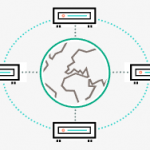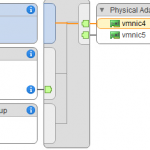HPE SimpliVity vBrownBag Build Day
Last week the vBrownBag team featured a HPE SimpliVity 380 Build Day Live.
Great detailed look at a SimpliVity deployment. Through the day they walked through a HPE SimpliVity Deployment from the unboxing of a HPE factory configured rack of SimpliVity gear, to the deployment of a SimpliVity 3+2 configuration (3 nodes in Production and 2 nodes for DR), to post-deployment testing, and finally migration of workloads from a legacy environment on to the SimpliVity infrastructure. Great technical hands-on overview of the entire process.
The recording of the live build is available for all and is embedded below:
Fantastic job @DemitasseNZ and team!!!
Some HPE folks were asking about providing an index of the video to be able to quickly get to different pieces and parts of the deployment and discussions. I figured this would probably also be useful to others. I put together an index which links to different parts (time stamps) of the build day video so you can watch the whole thing or you can jump around to see how a specific part of the deployment or how a specific task or feature is done.
There is also a playlist including the full build day video and all the individual videos taken as part of the event which can be found here: vBrownBag HPE SimpliVity Build Day Playlist
vBrownBag Build Day Showcasing Deploying HPE’s SimpliVity 380 HyperConverged Infrastructure (HCI)
7:20 – Introductions – vBrownBag Build Day Environment Overview
14:30 – HPE SimpliVity Deployment Process Overview
16:40 – vCenter Configuration – Datacenter and Cluster Creation for Production and DR
18:05 – HPE SimpliVity Arbiter Installation
19:30 – HPE SimpliVity Deployment Manager Installation
21:50 – Running Deployment Manager – Logging Into vCenter and Selecting the Production Cluster
Deploying the First Production HPE SimpliVity Node
22:50 – Deploying First Production HPE SimpliVity Node
23:30 – Scan to Discover HPE SimpliVity Nodes for Deployment
24:24 – Connect to iLO on the HPE SimpliVity Node for Remote KVM
25:30 – SimpliVity Installer on HPE SimpliVity Node
26:55 – Selecting Hypervisor Version
27:30 – Selecting Network Interfaces for Management and Storage/Federation
28:37 – Setting Host and OVC CLI Passwords
28:55 – Configure ESXi and OVC Management Network Settings
31:17 – Configure Storage Network Settings for Host (vmkernel) and OVC
32:37 – Configure Federation Network Settings for OVC
33:06 – Validate DNS Records and Configure Host DNS Settings
35:20 – Select NTP Servers for Host
36:17 – Review Deployment Details for First HPE SimpliVity Production Node
36:34 – Test Host Settings of First HPE SimpliVity Production Node (38:50 – Start Test)
40:36 – Start Deployment of First Production HPE SimpliVity Node
41:00 – Monitoring Deployment of First HPE SimpliVity Production Node
43:43 – Deeper Dive Into Alastair’s Lab Environment and Network Connectivity
46:40 – Unboxing Video Flash Back – Unboxing the HPE SimpliVity Factory Integrated Rack
1:08:55 – Back from Unboxing Video Flash Back – Q and A around factory integration, SimpliVity licensing, and vSphere licensing
1:13:27 – First Node Deployment Succeeded – New Node available in vCenter Inventory
1:14:40 – Start First Node Post Deployment Checks: SSH to OVC – Authenticate with vCenter Credentials
1:16:00 – Oops!(or around about there some technical difficulties with the screen capture) – The vBrownBag Team is Troubleshooting.
1:19:00 – Issues corrected, back to Post Deployment Checks on First Node Using the CLI Commands: svt-federation-show and svt-timezone-set
1:22:05 – Use vCenter Web Client to Create Datastore
1:23:00 – Create New Backup Policy
1:24:25 – Share Datastore with Legacy Host Using the CLI Command: svt-datastore-share
1:28:15 – Troubleshooting Sharing Datastore with Legacy Host
Deploying the Second Production HPE SimpliVity Node
1:29:50 – Deploy Second Production HPE SimpliVity Node
1:30:18 – Using the First Node Configuration File to Deploy Node
1:30:45 – Scan to Discover Nodes – Select Node to Deploy
1:32:04 – Select Network Interface Cards for Management and Storage/Federation
1:32:14 – Set Host and CLI Passwords
1:32:37 – Configure Management Network Settings – Update IP Addresses for Second Production Node
1:32:47 – Configure Storage Network Settings – Update IP Addresses for Second Production Node
1:32:55 – Configure Federation Network Settings – Update IP Addresses for Second Production Node
1:33:01 – Configure Host DNS Settings – Validate Settings from Configuration File
1:33:04 – Select NTP Servers for Host – Validate Settings from Configuration File
1:33:21 – Review Deployment Details for Second HPE SimpliVity Production Node
1:33:30 – Test Host Settings of Second HPE SimpliVity Production Node
1:35:18 – Start Deployment of Second HPE SimpliVity Production Node
1:35:23 – Monitor Deployment of Second HPE SimpliVity Node
1:35:55 – Discussion – What is Hyperconvergence/Hyperconverged Infrastructure/HCI?
1:41:14 – HPE Software Defined and Hybrid IT Product Portfolio with John Gromala
1:45:55 – Discussion – What is Unique about HPE SimpliVity HCI?
1:50:40 – Three key components of the HPE SimpliVity Data Virtualization Platform
1:53:12 – HPE SimpliVity Data Virtual Platform Overview with Brian Knudtson
– Notice the Second HPE SimpliVity Production Node Deployment Successful at 1:57:45
2:10:30 – Second HPE SimpliVity Node Post Deployment
2:11:10 – Post Deployment vSwitch Configuration of Production Nodes – Adding Network Interface Redundancy to vSwitches
2:12:44 – Show HPE SimpliVity Federation Using the CLI Command: svt-federation-show
2:13:23 – Share Datastore with Second Legacy Host Using the CLI Command: svt-datastore-share
2:14:16 – Migrate VM Storage from a Legacy Datastore to the HPE SimpliVity Datastore using Storage vMotion
2:16:02 – Migrate VM Compute from Legacy Host to HPE SimpliVity Host using vMotion
2:16:50 – Using PowerCLI Script to Configure vSwitch for VM Networks on SimpliVity Host
2:17:34 – Troubleshooting VM Compute Migration to HPE SimpliVity Host using vMotion
2:19:45 – Cloning a Large vApp (1/2 TB) from Legacy VSAN Datastore to HPE SimpliVity Datastore
Deploying the Final Production HPE SimpliVity Node and the First DR HPE SimpliVity Node
2:22:30 – Deploying First HPE SimpliVity DR Node – Brian Knudston is Deploying Final HPE SimpliVity Production Node in Parallel (off camera)
2:22:57 – Define Settings for Federation and Arbiter
2:23:09 – Using the First Production Node Configuration File to Deploy First DR Node
2:23:19 – Scan to Discover Nodes – Select Node to Deploy
2:24:05 – Select Network Interface Cards for Management and Storage/Federation
2:24:16 – Set Host and CLI Passwords
2:24:32 – Configure Management Network Settings – Update IP Addresses for First DR Node
2:24:42 – Configure Storage Network Settings – Update IP Addresses for First DR Node
2:24:56 – Configure Federation Network Settings – Update IP Addresses for First DR Node
2:25:01 – Configure Host DNS Settings and Select NTP Servers for Host – Validate Settings from Configuration File
2:25:03 – Review Deployment Details for First HPE SimpliVity DR Node
2:25:12 – Test Host Settings of First HPE SimpliVity DR Node
2:26:28 – Troubleshooting Failed vMotion – Retry vMotion from Legacy Host to HPE SimpliVity Host – 2:28:34 vMotion Successful
2:27:40 – Start Deployment of First HPE SimpliVity DR Node
2:27:43 – Monitor Deployment of First HPE SimpliVity DR Node
2:30:40 – HPE SimpliVity Scalability Video with Richard Greenwalt
2:37:25 – Shared Nothing vMotion from Legacy Datastore/Host to HPE SimpliVity Datastore/Host
2:39:24 – Discussion – Single HPE SimpliVity Node Deployment Use Cases
2:44:46 – HPE SimpliVity Use Cases (Core Datacenter, ROBO, VDI, Cloud/Service Providers, Tier 1 Applications, Backup/Data Protection, Test/Dev) Video with Brian Knudtson
– Note First HPE SimpliVity DR Node Deployment Successful at 2:49:53
Deploying the Second (and final) DR HPE SimpliVity Node
2:50:22 – Deployment of Second HPE SimpliVity DR Node in Background During HPE SimpliVity Use Cases Video
2:54:46 – Post Deployment Checks on HPE SimpliVity Federation Using the CLI Command: svt-federation-show
2:55:35 – Post Deployment vSwitch Configuration of Final Production Node and First DR Node – Adding Network Interface Redundancy to vSwitches
2:57:13 – Troubleshooting Web Client Issues
3:00:24 – Cloning vApp Using vSphere Clone on HPE SimpliVity Datastore
3:01:57 – HPE SimpliVity Capacity Efficiency
3:02:55 – Create a new VM in the HPE SimpliVity Production Cluster (Still having some issues with the Web Client so this task was not completed)
3:04:26 – HPE SimpliVity Product Portfolio (Appliance Sizes, Appliance Models, Gen10 Capabilities) Video with John Gromala
3:09:41 – Backup Policies Across Datacenters – Editing and Adding Rules to the Existing Policy for Remote Replication of Backups
3:14:24 – Use SimpliVity Clone to Clone a VM
3:15:19 – Use SimpliVity Backup to Manually Backup a VM – Local and Remote
3:18:55 – Delete a VM from the HPE SimpliVity Environment
3:20:38 – Restore VM from SimpliVity Backup to the HPE SimpliVity DR Cluster
3:23:08 – Monitoring SimpliVity Hardware – RAIN over RAID Discussion
3:24:57 – Post Deployment vSwitch Configuration of Final DR Node – Adding Network Interface Redundancy to vSwitches
3:25:57 – Production Cluster Capacity Efficiency Discussion
3:29:30 – HPE SimpliVity 380 Gen10 Hardware Overview with Richard Greenwalt
3:34:33 – OmniStack Accelerator Card
3:36:40 – OmniStack Accelerator Card/OmniStack Virtual Controller Resiliency
3:37:58 – Back to the Environment – Issue with Web Client Corrected (Chrome Cache Issue)
3:38:40 – Move a VM from the DR SimpliVity Cluster to the Production SimpliVity Cluster
3:41:10 – View Production Cluster SimpliVity Backup Catalog
3:41:30 – HPE SimpliVity REST API Demonstration
3:43:45 – Drive Failure Demonstration – Pulling Two Disks from Each Production Node – Six Drives Failed Across the 3 Production Nodes
3:48:20 – HPE SimpliVity vBrownBag Build Day Wrap Up
Again great job team!!! Look forward to the next one.




For all things SimpliVity AND VMware, this is an incredible site. PLEASE keep it going Hersey.